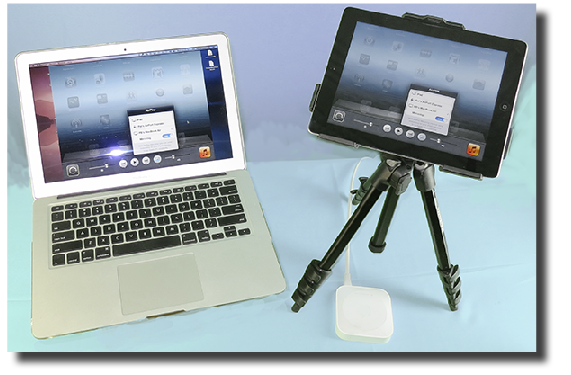Wireless Presentations using an iPad
by Pat Brown
Pat Brown shows how an iPad can provide wireless presentation capability for your meeting space.
 SynAudCon recently presented at the Consortium of College and University Media Centers in Las Vegas, NV. We had AV personnel from two dozen universities in the class. Each break I had several inquiries into how I was presenting from the iPadTM. It seems that many of the professors they work with want this capability. There are a number of possibilities, and this information is readily available on the Internet. There are some gotcha’s so I will share my experiences here. It may save you some time. I was assured by the experts at the Apple Store that this setup would not work. I suspected that it would, and have now used it successfully in two seminars.
SynAudCon recently presented at the Consortium of College and University Media Centers in Las Vegas, NV. We had AV personnel from two dozen universities in the class. Each break I had several inquiries into how I was presenting from the iPadTM. It seems that many of the professors they work with want this capability. There are a number of possibilities, and this information is readily available on the Internet. There are some gotcha’s so I will share my experiences here. It may save you some time. I was assured by the experts at the Apple Store that this setup would not work. I suspected that it would, and have now used it successfully in two seminars.
At the heart of the process is a feature of Apple devices called AirPlayTM.
The key ingredients are:
1. AirPlay source (sender of the AirPlay signal)
2. Wireless LAN
3. AirPlay client (receiver of the AirPlay signal)
Plan A – AppleTVTM as AirPlay Clent
The iPad can use AirPlay to send its screen to an AirPlay client. One such client is the AppleTV. This is done wirelessly over a local area network (LAN). If an AppleTV and an iPad are on the same Wi-Fi network, you can mirror the iPad screen to the AppleTV, whose HDMI output can be connected to a video projector, television, etc. Simple enough. The steps to mirror the iPad screen are:
1. Press the “home” button twice.
2. Swipe right on the applications bar.
3. If an Airplay client is available, you will see the AirPlay icon and be able to select it (Fig. 1).
This approach is not without issues. Some rooms don’t have a wireless LAN, or if they do they may require permissions/passwords that may not be available to myself as a presenter. The AppleTV only has HDMI output. Some projectors can accept this directly, but for most you will need an HDMI-to-VGA converter. Another problem is that the audio from the iPad will be coming from the optical output of the AppleTV, which may not be in a convenient location for interfacing into the house sound system. And lastly, if you need to also use your PC in the presentation, both it and the AppleTV must drive the projector and you will need to switch between them during the presentation. Do-able, or course, but clunky without hauling around a video switcher.
So, while the AppleTV approach is attractive at first glance, I could only get it to work reliably under controlled conditions using my own projector. The chances of showing up at a meeting room in Anywhere, USA and having this work are slim.
Plan B – Notebook PC as AirPlay Client
There are a number of low cost apps that make an Apple or WindowsTM PC show up as an AirPlay client to the iPad. I tried several and ended up using ReflectionTM. My MacBook is interfaced to the projector in the usual manner. With Reflection running, I can mirror the iPad screen to the MacBook. The LAN requirements are easily addressed by using a dedicated wireless access point. I keep an Apple AirPort ExpressTM in the backpack for this purpose. Any wireless router should work. I simply plug it into an electrical outlet anywhere in the meeting room. Both the MacBook and the iPad can see it and log on. If you need Internet access (I usually don’t) you can then bridge the AirPort Express onto the local network. Be sure to use encryption to keep others in the room off of your network.
The huge advantage of this approach is that I can use the MacBook along with the iPad. If the iPad or AirPlay dies, the MacBook keeps going – flexibility and redundancy all-in-one. Plus, I can set the iPad to play through either the MacBook’s internal sound card, or my USBPre2TM connected via USB to the PC. This gives me a high quality balanced analog output to the sound system.
It is my hope you can benefit from my false starts, and quickly and affordably provide wireless presentation capability for your meeting space. pb
Download a PDF of this article.


